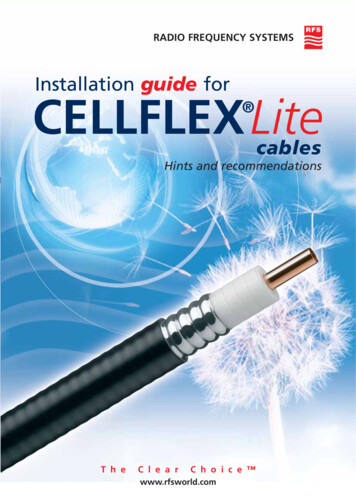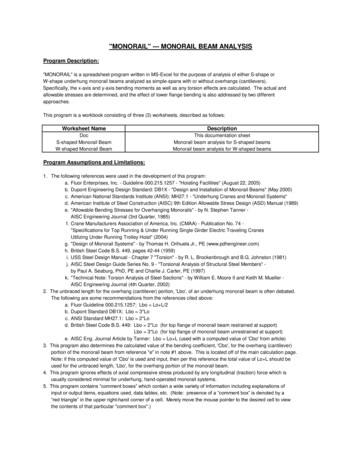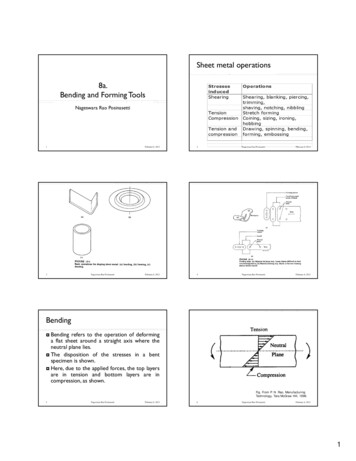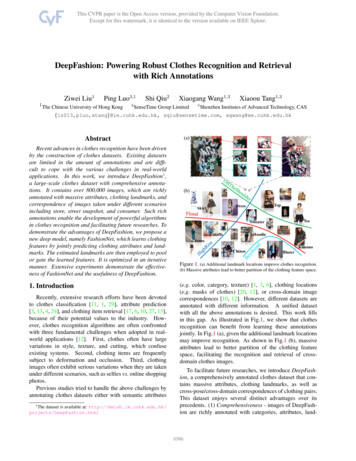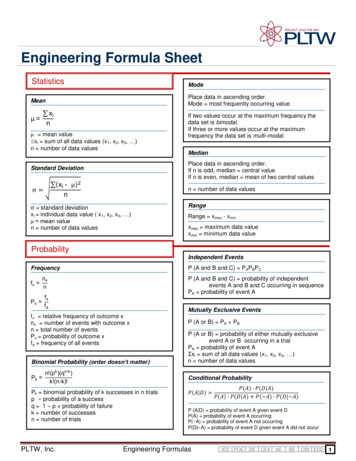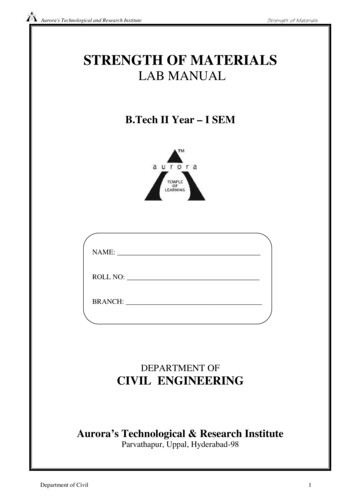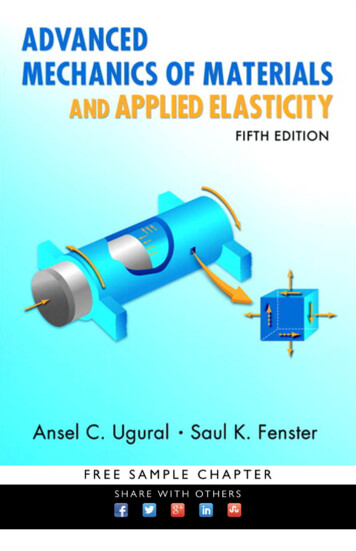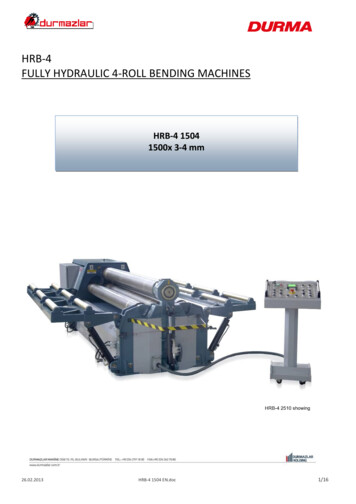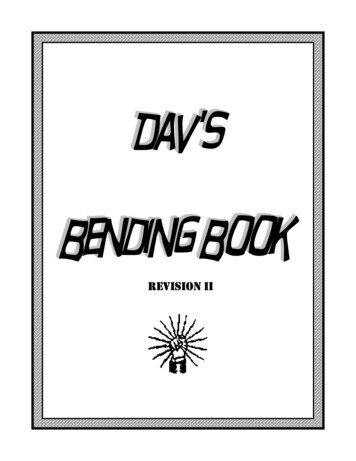
Transcription
REVISION II
Created By: David L HensleyLocal Union # 903 IBEWAcknowledgment:This little book was created from many different books, but mainly from the one thathas helped me to bend conduit for many years. Thank you to the man that wrote“Professor Brown’s Guide to Conduit Bending”
To Determine Offset Loss (amount that conduit is shortened by bending an offset)center of bend2”30ºp)(hy4”(opp)center of bend(adj)3 7/16”center of bend9/16”4” Find the length between bendssinӨ opphyp opp x 1hypsinӨhyp opp x cscӨ2” (height of offset)x 2(csc 30º)4” ( hyp - length between bends) There is more than one way to find the (adj):use the cosӨuse Pythagorean theoremcosӨ adjhyphyp² adj² opp²adj cosӨ x hypadj hyp² – opp²adj .866x 43.46 or 3 7/16”adj 16 – 4 3.46 or 3 7/16”Subtract the side (adj) from the distance between bends (hyp) this gives you the shrink inconduit. Use this when you have to cut and thread before bending or when you want thecenter of your bend to fall out at a specific location.4“ – 3 7/16” 9/16”
Parallel Offsets Progression of Bends2” (C–30º6”º–(C2”15adj2” (C–opp9/16”6 9/16”When bending two or more offsets it is necessary to advance the centers of the bends for theprogressive conduits in order to maintain an equal center to center spacing.Multiply the (C-C) measurement of the conduits by the tangent of 1/2 the bend angle. Add thisfigure to the center of bend measurement of 1st conduit. This will be center of bend measurement of the 2nd conduit. Advance the center of bend measurement of each succeeding conduitby this figure.Example:tanӨ oppadjopp tan 15º x adj (C-C)opp .2679 x 2”opp .5358’ or 9/16”
To Bend Kicks to Any Given AngleBack of 904 1/2”4”1/2”SFCenter of Bend4” 30 bendAmount of Kick2”Front of ShoeCenter of BendAfter determining angle to use, bend this angle in a piece of scrap conduit. Measure from the frontof the shoe to the center of the bend. This is the shoe factor (SF). Multiply the cosecant of the bendangle by the amount of kick. Add 1/2 O.D. of the conduit. This is the center of the bend measuredfrom the back of the 90 . Deduct the (SF) figure and place the front of bending shoe on this mark.Pull through proper amount of travel for desired angle.Example:30 Kick2” amount of kick2”(amt of kick)x 2(csc 30 )4” 1/2(1/2 O.D.)4 1/2”(Center of Bend)- SFFront of Shoe
Kicks with Conduits Running Parallel to CabinetTo find centers of KO’s in cabinet and maintain centers (2”) of conduits, multiply center tocenter (C-C) measurement by the cosecant of the bend angle.Example:4” (C-C of KO’s)xC2”-C30 2” C-C2”24”(C-C measurement)(csc 30 )(C-C of KO’s)
Kicks with Conduits running Perpendicular to Cabinet2 7/8” C – C of KO’shypadj21/2”C–Ccos Ө adjhypӨ 30º30 cos (30º) adjhyphyp adjcos(30º)hyp 2.5”.866hyp 2.887”hyp 2 7/8”2 1/2 “ C – CTo find centers of KO’s in the cabinet and maintain centers (2 1/2”) of conduits, divide the(C – C) measurement by the cosine bend angle.
To Find Centers of 45 bends Having Conduit SupportsDA1/4”F36”7/8”3”Measure from corner (A) to center of conduit (B). Multiplythis figure by 2. This is (C–D) measurement. Add the O.D.of the conduit and the depth of supports on each side andmultiply this figure by 1.414. Subtract this figure from the(C–D) measurement. This figure is the (E–F) measure-Bment,Eor center to center measurement.1/4”CExample:1”(1) 3” (A–B)x 26” (C–D)(2)1.0” O.D.25support .25support1.50”(3) 1.414x 1.5”2.121”(4)6.00” (C–D)- 2.12”3.88” (E–F) (center to center)To Find Centers of 45* bends with Square Obstruction341/4”(C)3/4”(C-C)1 1/2” (B)1 1/2” (A)Add (A) and (B) measurements and multiply by 1.414This is the back of the conduit (C). For the center tocenter measurement (C-C) deduct 1/2 O.D. of theconduit.Example:(1)(3)1”1.5” (A) 1.5” (B)3”(2)1.414x 3”4.242”4 1/4” (C)4 1/4” (C)- 1/2” (1/2 O.D.)3 3/4” (C-C)Note: - If the conduit is on supports add the depth of the supports on each side andmultiply by 1.414. Subtract this figure from (C-C) measurement.- To obtain more clearance increase the (C) measurement 2” for each 1” ofclearance.
To Find Centers of 45 bends with Rectangular Obstruction3Add (A) and (B) measurements and multiply by 1.414This is the back of the conduit (C). For the center tocenter measurement (C-C) deduct 1/2 O.D. of theconduit.41/4”(C)3/4”(C-C)1” (A)2” (B)Example:(1)(3)2” (A) 1” (B)3”(2)1.414x 3”4.242”4 1/4” (C)4 1/4” (C)- 1/2” (1/2 O.D.)3 3/4” (C-C)Note: - If the conduit is on supports add the depth of the supports on each side andmultiply by 1.414. Subtract this figure from (C-C) measurement.- To obtain more clearance increase the (C) measurement 2” for each 1” ofclearance.1”41345/ /16”16(”(C B)-C)2”DTo Find Centers of 45 bends with a Round ObstructionMultiply diameter of round object by 2.4. This is the back of theconduit (B). For center to center measurement (C-C) deduct 1/2 O.D.of the conduit.Example:(1)2.4x 2 (D)4.8”4 13/16” (B)(2)4 13/16” (B)- 1/2” (1/2 O.D.)4 5/16” (C-C)Note: - If the conduit is on supports add the depth of the supports on each side andmultiply by 1.414. Subtract this figure from (C-C) measurement.- To obtain more clearance increase the (B) measurement 2” for each 1” ofclearance.1”
4”(B)Multiply (A) measurement by 3. This is the back of theconduit (B). For center to center measurement (C-C) deduct1/2 O.D. of the conduit.41/2”2”1/111/2”(C-C)(A)11/2”To Find Centers of 45 bends with a Square ObstructionExample:(1)1.5” (A)x 34.5” (B)(2)4.5” (B)- .5(1/2 O.D.)4.0” (C-C)Note: - If the conduit is on supports add the depth of the supports on each side andmultiply by 1.414. Subtract this figure from (C-C) measurement.- To obtain more clearance increase the (B) measurement 2” for each 1” ofclearance.1”To Find a Radius Required to Clear an ObstructionA12”1/B31/8”38”5/Measure from (A) to (B). Multiply by 2.4. This is to outsideradius of the bend. Deduct 1/2O.D. of the conduit for thecenterline radius. To obtainmore clearance, increase thedistance from (A) to (B).Example:1.5” (A-B)x 2.43.6” 3 5/8” (outside radius)- .5”1/2 O.D.3.1” 3 1/8” (centerline radius)1”
Bending a 90 Bend Using 3 - 30 BendsB21 1/2”AC3”23/4”30 2”A130 33/4”4”CBTo bend a 90 bend using 3 - 30 bends as shown:Multiply side ‘A’ of2” X 2 4”1 by the cosecant of 30 , that equals side ‘C’Multiply side ‘A’ of1 1/2” X 2 3”2by the cosecant of 30 , that equals side ‘C’30 Multiply the tangent of 1/2 the bend angle by the O.D. of the conduit.Subtract this from the length of side ‘C’ in eachfor the center - centermeasurement.Tan 15 .2679.2679 X 1” 1/4”4” - 1/4” 3 3/4”3” - 1/4” 2 3/4”1”
Bending a 90 Bend Using 3 - 30 BendsB21 1/2”AC3”23/ 4”30 1 1/2”A123/4”C3”A30 To Bend a 90 bend using 3 - 30 bends as shown:Multiply side ‘A’ of 1 by the cosecant of 30 to obtain the length of side ‘C’.Since the obstruction is square, side ‘C’ of30 2will be the same as inMultiply the Tangent of 1/2 the bend angle by the O.D. of the conduit. Subtractthis from the length of side ’C’ for the center - center measurement.1 1/2” X 2 3”Tan 15 .2679.2679 X 1” 1/4”3” - 1/4” 2 3/4”1”1
To Figure Amount of Offset Needed for A Rolling �(C)Pythagorean theorem A² B² C²4” (A)4Example:533” (B)Measure the distance the conduit has to offset up or down and the distance ithas to offset right or left. Mark these two figures on any square and measurebetween them as shown. This will be amount of offset required.131211109876C² 4² 3²C² 25C 25C 5 (amount of offset)C² A² B²C² 4² 3²C² 25C 25C 5C² A² B²C² 5² 4²C² 41C 41C 6.403 (6 3/8”)C² A² B²C² 5.5² 5.5²C² 60.5C 60.5C 7.778 (7 3/4”)When laying out a slab to get a square wall use the carpenter’s rule calledThe 3, 4, 5 rule. Just like the triangle above, take any number multiply it by3, 4, and 5 use these numbers to lay out a square wall.5’ x 3 15’5’ x 4 20’5’ x 5 25’C² A² B²25² 15² 20²25² 62525 62525 2513
Gain for 90º Bends7 3/4”31 1/2”36”(C)7 3/4” 31 1/2”39 1/4”- 36 ”(C actual amount of conduit)3 1/4” (amount of gain)Gain is the difference between the sum of right angle measurements of both legs of the 90º bend and theactual amount of conduit required to make the 90º bend. For standard shoes on Chicago benders the gain is3 times the outside diameter of the conduit ( or – a fraction of an inch).To determine the gain of your bender take a scrap piece of conduit of the size needed. Use 3/4” for theexample, and the length is 36”. Put the end of the conduit flush with the front of the shoe and bend a 90º.Measure both legs of the bend very carefully. Say that the two sides measured (7 3/4”) and (31 1/2”), addthe two sides (7 3/4” 31 1/2” 39 1/4”) Subtract the original length of the conduit form this figure(39 1/4” - 36” 3 3/4”). This is the gain for a 3/4” 90º.This is used to cut and thread conduit before bending. Another use is to obtain a figure for back to back 90ºbending. If you have back to back 90ºs that are 5 foot, 6 foot, or longer, it is more practical to reverse theconduit in the bender and bend up the short end of the conduit. By putting the original conduit even withthe front of the shoe, you now have the stub-up length of the bender (7 3/4”). To obtain back to back figuresubtract the gain from the stub up. ((7 3/4” - 3 3/4”) 4”) Add this figure to the length of the back to backbends.Front of Shoe76”4”
Bending Conduit Using the Travel MethodTo bend conduit using the travel method, place conduit in bender and mark at the back of the rear conduit support. Bend a 90º bend and mark the conduit at the back of the rear conduit support again. Besure the 90º bend is perfect by checking with a square or a protractor. Measure between the 2 marks.This is the amount of travel for a 90º angle. Divide this figure by 90. This figure is you coefficientnumber or amount of travel for 1 degree. To find the amount of travel for a specific degree, multiplythe coefficient number by the desired degree.Example:Travel for 3/4” 90º 7 1/4”.080” (coefficient #)90 7.25”15º x .080” 1.208” 1 3/16” (travel for 15º)20º x .080” 1.6” 1 5/8”(travel for 20º)30º x .080” 2.4” 2 3/8”(travel for 30º)Bend a trial offset in a piece of scrap pipe using the angle you want to bend. You can then adjust youtravel figure by pulling a little more or less travel.Problem:To bend a 3 3/4” offset with 20º bends in 3/4 “ conduit:First multiply the amount of offset by the cosecant of the bend angle for the distance between bends(3.75 x 2.92 10.95 or 10 15/16”). Place 2 marks 10 15/16” apart on the conduit. Put the 1st mark atthe front of the bending shoe and engage the bender. With the weight of the handle on the conduitmeasure back and mark the conduit 1 5/8” behind the rear conduit support. Pull the conduit throughuntil this mark is at the back of the conduit support. Release and rotate the conduit 180º and place the2nd mark of your between bends measurement at the front of the bending shoe. Tighten bender toconduit and mark 1 5/8” behind the conduit support. Pull the conduit to this point, and this will giveyou a 3 3/4” offset bent at 20º.To match existing offsets:Measure the amount of offset and the distance between bends. Divide the distance by the amount ofoffset. This will give you cosecant of the bend angle. Find this cosecant on the chart and the corresponding angle will be the bend angle. You can also use the inverse cosecant on your calculator.Example:Match an existing offset of 3 3/4” with distance between bends of 7 1/2”.23.75 7.50(csc (30º)) bend angle
2” R4”DCircumference of a circle (360 ) D π 2 R ππ 3.1416Circumference of 1/4 of a circle (90 ) Developed lengthDev. Length R 2 π4Dev. Length R 2 (3.1416) R x 1.574Multiply the radius by 1.57 for the Dev. Length of a 90 bend. This is the amount of straightconduit required to make the bend.
Example:To make a 90 bend with a 4” center line radius: Multiply the radius (4”) by 1.57 for the Dev.Length (6.28). Divide by one less than the amount of bends, for example 9 – 1 8 spaces.Bend 10 at each line.785 or 3/4”Dev Length 1.57 x 4” 6.28”8 spaces R
To bend a 90º of any given radius: Determine radius. Code states a minimum of six times theinside diameter of conduit of the inside radius of a 90 bend. Add 1/2 outside diameter of conduit for centerline radius. To determine how many spaces to use and how many degrees tobend use this rule: Length of spaces should not exceed 3” to keep the elbow smooth.For DL up to 18” - use 8 spaces and bend 10 .For DL of 19” to 36” - use 17 spaces and bend 5 or 14 spaces and 6 .For DL over 36” - use 29 spaces and 3º.You can use any number of spaces. Divide number of spaces 1 into 90 to determine numberof degrees to bend.After you determine how many spaces you will use divide the DL by this number. This will bethe length of each space. Mark the conduit and bend the proper number of degrees ant each line.3”A1.25”B3”2. 5”To find radius of 90 bend:Place straight edge on conduit and mark where bend starts. Placestraight edge on back side of 90 and measure to the mark (3”). This isthe outside radius of the bend. Deduct 1/2 of the O.D. of the conduitfor the centerline radius.Another Method:Measure from point ‘A’ to point ‘B’. Multiply this figure by 2.4 toobtain the outside radius of the conduit. Deduct 1/2 of the O.D. of theconduit for centerline radius.AB1”1.25”x 2.43.00” outside radius- .5” 1/2 O.D.2.5” centerline radius
Concentric Bends331/8”R28243/ 83/4”R”R20” RExample:2”2”2”O.D. of 2” conduit is 2 3/8”4 3/8” 4 3/8” 4 3/8”20” R24 3/8” R28 3/4” R33 1/8” RBend four concentric 90 bends in 2”conduit with 2” spacing between conduits. Use a 20” centerline radius forthe smallest radius. The next radius willbe 20” the cen.– cen. measurement ofthe 2 conduits, which is 4 3/8”. TheO.D. of the 2” conduit is 2 3/8” so 1/2O.D. (1 3/16”) space (2”) 1/2 O.D.(1 3/16”) 4 3/8” center to center.The 2nd radius will be 24 3/8”The 3rd radius will be 28 3/4”The 4th radius will be 33 1/8”Multiply each radius by 1.57 for Developed length1 20” X 1.57 31.40 31 3/8”2 24.375 X 1.57 38.269 38 1/4”3 28.75 X 1.57 45.138 45 1/8”4 33.125 X 1.57 52.006 52”Divide each D.L. by 17 (# of spaces)1 31.40 / 17 1.847 1 13/16”2 38.269 / 17 2.251 2 1/4”3 45.138 / 17 2.655 2 5/8”4 52.00 / 17 3.058 3 1/ 16”Mark each conduit from the same starting point 17 spaces 18 marks. Bend 5 at each mark.
32 1/2”(A)To Find Radius of a Tank or Arc(C)XY6’ (B)6’ (B)(O)XY — Chord of arcO — Center of Cord of arcA — Height of arcC — Cord of 1/2 the arcR — radius8’ (R)The chord is found by laying out 2 points on the circle. These points must be less than thediameter. Make these points (X and Y) an even measurement such as 6’, 8’, 10’ ect. From thecenter point of XY (O) measure at a right angle to the circle. This figure (A) is the height ofthe arc. To find the cord of 1/2 the arc use the Pythagorean theorem. To find the radius of thecircle use the formula R C² / 2(A).A² B² C²R C² / 2(A)C A² B²R 6240.25 / 2(32.5)C 32.5²” 72²”R 96.0” (8’)C 6240.25”C 78.9”
To Determine a Radius of Conduit around a Tank1810’8.4Radius of Conduit188.4”19’10’Radius of Tank184”8.188.4”Measure from center of tank to center of conduit. Multiply this figure by 1.57 and convert to inches. This is the developed length for 90 or 1/4 of the circumference of the conduit if it ran completely around the tank. Developedlength (188.4“) / spaces (89) 2.12” or 2 1/8”. Bend 1 at each line. These figures will be the same no matter howfar the conduit runs around the tank.If it is easier to measure around the tank (678.85“) divide this figure by 3.1416 (678.58 / 3.1416 216”)For the diameter of the tank. 1/2 of this figure (108“) is the radius of the tank. Add the distance from the tank to thecenter of the conduit (12”) for the centerline radius of the conduit (120”)Example:(1)(2)216”3.1416 678.85”216” 108”2(tank diameter)(tank circumference)(4)120” (centerline radius)x 1.57188.4” (Developed length for 90*)(9’ tank radius)2.12” or 2 1/8 (Length of spaces)(3) 108” 12” 120” (10’ centerline radius)(5) 89 188.4It is almost impossible to bend at one degree. Sometimes it is better to have flat spots between bends and bend at 3 or5
Tray Cuts for Any Given Angle1.07”2”.5358.535815 15 30 cutTo determine amount to cut from the tray for any given angle: Multiply the depth (or width) of the tray by the tangentof 1/2 the cut angle. Cut this amount from each side of the center line.Tan 15 opp (amount to cut each side of center)adj (depth of width of tray)opp Tan (15 ) X adj (2”)opp .2679 X 2”opp .5358” 17/32”Cut 17/32” from each side of the center line
Tray Cuts for Offsets9/169/163”2”6”6 9/16”For center to center of cuts on trayoffsets. Multiply amount of offset bythe cosecant of the angle needed. Multiplythe Tangent of half that angle by the depth orwidth of the tray. Add this to the first figure.EXAMPLE:3” offset30º2”deep tray(offset X csc 30º ) (Tan 15º X depth) CC(3” X 2) (.2679 X 2”) CC6” .5358” (9/16”) CC6 9/16” CC
Conduit3/4’1”1 1/4”1 1/2”2”Travel 15*1 1/4”1 1/2”1 7/8”2 1/4”2 1/2”Travel 20*1 5/8”2”2 1/2”3”3 3/8”Travel 30*2 3/8”3”3 3/4”4 1/2”5”Travel 45*3 5/8”4 5/8”5 5/8”6 3/4”7 1/2”Travel 90*7 3/8”9 1/4” 11 1/4” 13 1/2” 15 1/8” 2” Offset Hyp.4 3/4”5 5/8”6 7/8”8 3/4”Travel Chart – Figures are approximateand may vary a little with each bender.Cross reference degree of bend andconduit size. This is the amount to pullthrough for the angle.13 1/2”UnknownKnown5 10 15 20 25 30 45 60 85.966.939.906.866.707.50COSS amount of offsetL length between bendsR center to center of bends after offset is completedSLRTo find unknown: Multiply known figure by the multiplier for desired angle.Example:Find (R) if the amount of offset (S) is 2” and the bends are 30 . If (S) is known and (R) isthe unknown, that would be line 3 of the chart. Under 30 you find the multiplier is 1.73.Multiply 2” (S) by 1.73 and (R) 3.46” or 3 7/16”.
Trigonometry FunctionssinӨ opphypcosӨ adjhyptanӨ opphypcotӨ adjoppsecӨ hypadjcscӨ hypoppPythagorean TheoremA² B² C²3,4,5 rule (right angle rule)543Circumference of a circleC Rx2xπ
Using a Folding Rule to Find /32”34.311 3/4”65.915 7/8”4.721/16”37.022”68.406 3/8”6.981/8”39.742 1/4”70.827”9.253/16”42.472 5/8”73.257 3/8”12.271/4”45.162 15/16”75.587 3/4”15.303/8”47.853 1/4”77.928 1/4”18.001/2”50.503 9/16”80.188 764 3/8”84.619 7/16”26.131”58.374 9/16”86.7810 1/16”28.861 1/8”60.904 7/8”88.3910 3/8”31.601 3/8”63.435 9/16”90.0010 3/4”Use folding rule to check degrees. Fold the rule at 18” joint and again at 36” joint. Whenthe end is at 10 3/4”, a 90 degree bend is formed at the 18” joint. The opposite side of the18” mark is 54”485410 3/4”12182430364260666
Multiply side ‘A’ of by the cosecant of 30 to obtain the length of side ‘C’. Since the obstruction is square, side ‘C’ of will be the same as in Multiply the Tangent of 1/2 the bend angle by the O.D. of the conduit. Subtract this from t

